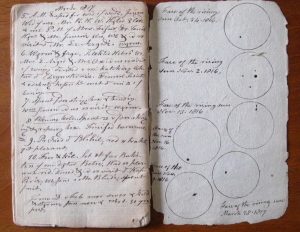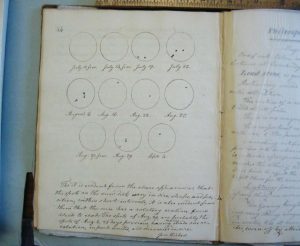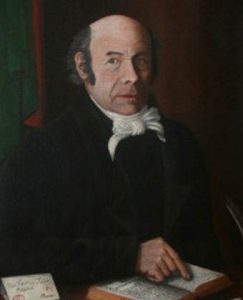25 July 2017
Researchers uncover 200-year-old sunspot drawings in Maine
Posted by ksimpkins
By Kelsey Simpkins
When the summer of 1816 was abnormally cold, with severe frosts in June and snow in July, Reverend Jonathan Fisher did what he always did: He documented it in his journal.
Fisher, a Harvard-educated minister in the small coastal town of Blue Hill, Maine, used his own phonetic shorthand to record events and observations of the natural world for 45 years. In the summer of 1816 through 1817, Fisher wrote about the weather in understated terms: commenting on the late planting of his potato crop, detailing the smaller-than-usual harvest, and remarking through the winter that conditions went from “quite cold” to “very windy and excessively KOLD.”
In April of 1815, the volcanic eruption of Mount Tambora in Indonesia caused a global decrease in temperatures for the following few years, and 1816 came to be known as the “year without a summer.” New England states were particularly hard hit by these temperature changes, which significantly affected agriculture production and quality of life.
But no one in North America or Europe knew exactly why temperatures had dropped or that Mount Tambora was to blame. Fisher and others wondered about the possible association of cooler temperatures on Earth with sunspots, dark patches on the sun that scientists now know are regions of intense magnetic field activity. Alongside his journal entries, Fisher sketched the sunspots during the summer of 1816, thinking they might be responsible for the cold summer temperatures.
“People were genuinely concerned that something was going amiss with the sun. They had no reason to expect that temperatures would return to normal… [they were] concerned that life as we know it would perhaps come to an end,” said William Denig, chief of the Solar and Terrestrial Physics Division at National Oceanic and Atmospheric Administration in Boulder, Colorado, and lead author of a new paper detailing the findings of Fisher’s sunspot drawings that has been accepted for publication in Space Weather, a journal of the American Geophysical Union.
A fortunate discovery

Sunspot drawings in Jonathan Fisher’s journal from 1816.
Credit: Jonathan Fisher Memorial / American Geophysical Union
Two centuries later, Michael McVaugh, a historian of science at the University of North Carolina, inadvertently uncovered Fisher’s sunspot drawings.
McVaugh spends his summers in Maine and serves as a docent at the historic Fisher House in Blue Hill, built by the minister himself from 1814 to 1818. Residents had known about Fisher’s journals for many years: They were translated and transcribed in the 1940s, and a digitized copy now resides at the library in Blue Hill.
Before the 200th anniversary of the year without a summer, McVaugh thought it would be interesting to see what Fisher had said about his experience in the cold summer of 1816. After reading the transcriptions, he consulted the journals themselves, held by the Fisher House, and was surprised to find the sunspot drawings – some of the first done in North America and some of the only sketches from the early 1800s. Fisher had made drawings of the sun once or twice a month from the middle of June 1816, when it was snowing in Maine, until 1817, when temperatures returned to normal.
“To my astonishment, … when I looked at the actual journals I discovered, that he had made these careful drawings,” McVaugh said.
Improving the global sunspot index

Sunspot drawings in Jonathan Fisher’s journal from 1817.
Credit: Jonathan Fisher Memorial / American Geophysical Union
Fisher’s rare sunspot drawings could help scientists better understand the historic activity of the sun and could help researchers gain better insight into the sun’s activity today. This rare find might also well inspire a renewed interest in examining the personal journals of early American scientists for additional and previously unknown sunspot drawings and other observations, the study’s authors said.
While complex computer models are used today to understand climate and weather, sunspots still provide a useful index of the sun’s activity and scientists continue to keep track of sunspots today. The more sunspots, the more active the sun is. Solar activity such as solar flares and coronal mass ejections can disrupt radar and radio communications when they enter near-Earth space – a phenomenon called space weather.
Scientists use a global index of sunspots to monitor the sun’s approximately 11-year solar activity cycle. This index is an excellent indicator of space weather and is used to assess potential space weather impacts on satellites, radio communications and the electric power grid. Long-term changes in the strength of successive solar maximums – when the sun’s activity is at its peak – can reveal clues about the physical nature of the sun.
A recent re-calibration of the full sunspot record going back to the early 1600s has provided a better historical assessment of solar activity and its impact on society. Fisher’s drawings had not yet been discovered at the time the global index was re-calibrated, and they could provide additional refinement of this historical index, according to the study’s authors.
Except for solar observations from 1779 to 1818 made by Sir William Hershel in Cambridge, England, a few of which overlap almost to the day with Fisher’s in 1816, there are no other known sunspot records from the early 1810s. Fisher’s could possibly be the only sunspot records from the early 1800s made in the United States.
Practicing science
The study’s authors said that although Fisher did not have a Ph.D., he was still a scientist in his day. In 1816, science was mostly “the practice of making and recording careful, systematic observations,” according to McVaugh. The first Ph.D. wasn’t awarded in the United States until the 1860s.
Fisher thought with his eyes, he was a good artist, and even constructed a camera obscura in order to make accurate, photo-like paintings of the world around him. He also speculated on the sun, proposing it was like a big puddle of lava with many eruptions going on. Ironically, Fisher thought the sun was made up of volcanoes, “when in fact the source of what got him interested in this whole thing was a volcano on Earth,” Denig said.
— Kelsey Simpkins is a public information intern at the American Geophysical Union and a graduate student in journalism at the University of Colorado Boulder.



 GeoSpace is a blog on Earth and space science, managed by AGU’s Public Information staff. The blog features posts by AGU writers and guest contributors on all sorts of relevant science topics, but with a focus on new research and geo and space sciences-related stories that are currently in the news.
GeoSpace is a blog on Earth and space science, managed by AGU’s Public Information staff. The blog features posts by AGU writers and guest contributors on all sorts of relevant science topics, but with a focus on new research and geo and space sciences-related stories that are currently in the news.
Thanks for this fascinating report. Of interest is how Fisher’s observations of weather nicely parallel Thomas Jefferson’s, particularly those from 1810-1816 following his retirement from the Presidency. Jefferson’s data clearly show the temperature reduction apparently caused by the Tambora eruption.